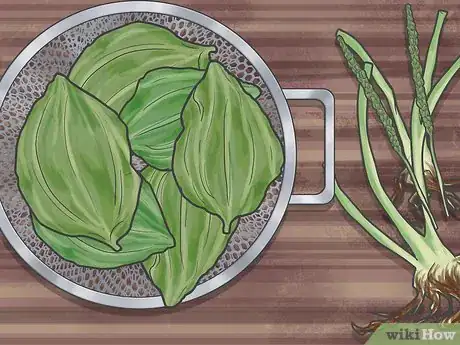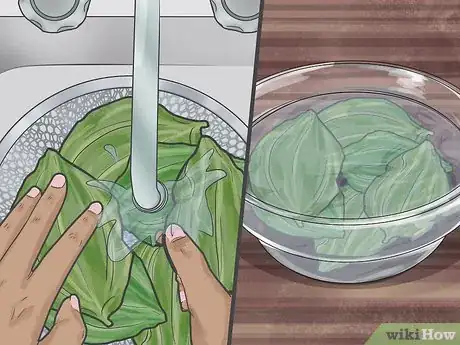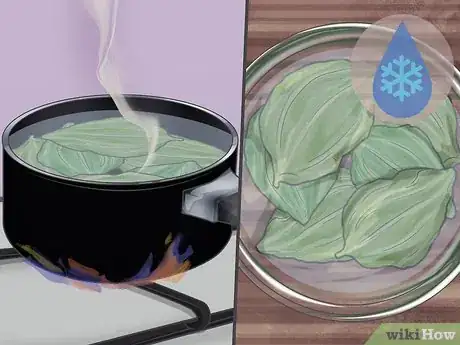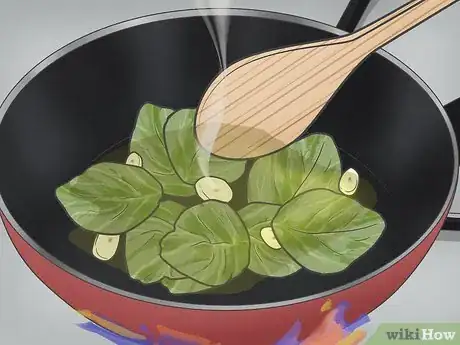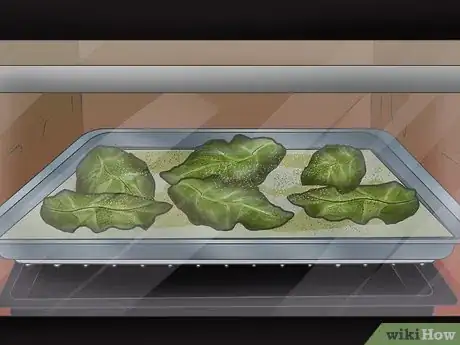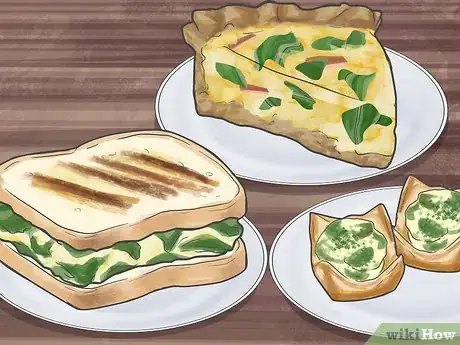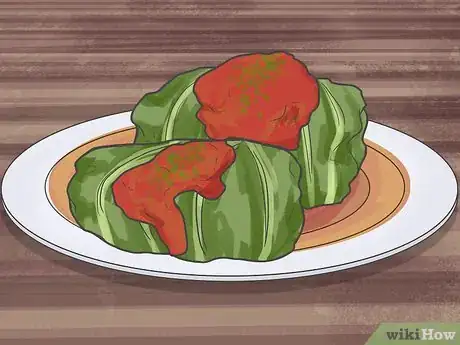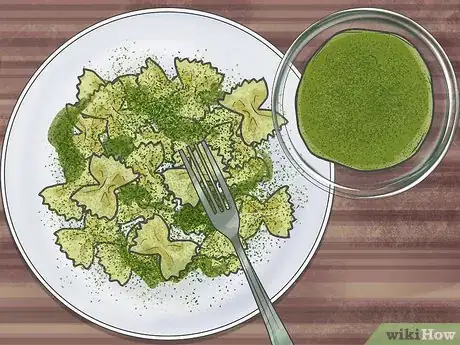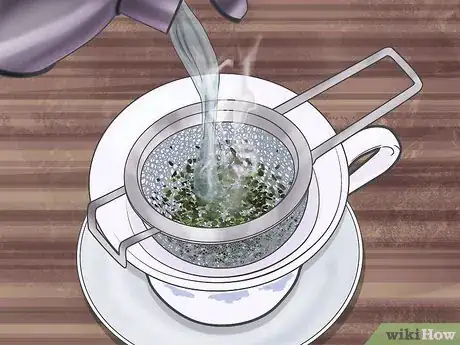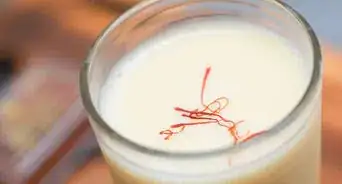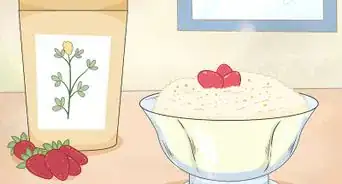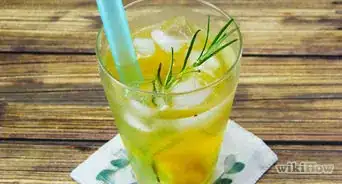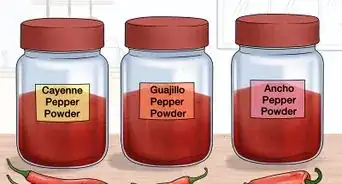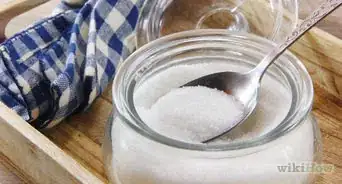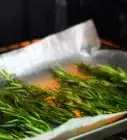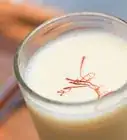This article was co-authored by wikiHow Staff. Our trained team of editors and researchers validate articles for accuracy and comprehensiveness. wikiHow's Content Management Team carefully monitors the work from our editorial staff to ensure that each article is backed by trusted research and meets our high quality standards.
There are 18 references cited in this article, which can be found at the bottom of the page.
This article has been viewed 30,695 times.
Learn more...
Plantago, or plantain, is a type of herbaceous plant that’s commonly found in wet, temperate areas. Despite often being mistaken for a weed, plantains are a popular food among those who know how to correctly identify them, and can serve as a healthy, all-natural source of nutrients. Once you’ve picked the leaves, you can use them the way you would spinach, kale, or other fresh greens—boil them, toss them into a stir fry or simply serve them raw in a colorful organic salad.
Steps
Rinsing and Chopping Plantain Leaves
-
1Separate the leaves from the rest of the plant. Plantain plants have many different parts, including the leaves, roots, tough, fibrous shoots and flowering seed stalks. For most recipes, it will be easiest to work with just the leaves. Pull the leaves gently from their stems and set them aside in a shallow bowl or colander for rinsing.
-
2Wash the leaves thoroughly. Run the leaves under a stream of cool water while tossing them lightly by hand. This will help remove any loose dirt or debris clinging to them. For a more thorough cleaning, let the leaves soak at the bottom of a bowl of water for a minute or two.[3]
- Swishing the leaves in a mixture of water and apple cider vinegar can also help kill any lingering bacteria.
- To dry the leaves, shake off the excess water, then sandwich them between layers of folded paper towels.
Advertisement -
3Chop or tear the leaves into bite-sized pieces. Plantain leaves can grow quite large, so you’ll often have to cut them to make them more manageable. Stack the leaves on top of one another and slice them into halves or quarters, or simply tear them to the desired size by hand. The exact size of the leaves will depend largely on the recipe you plan to use them in.[4]
- Young plantains bear small, tender leaves that can be eaten whole.[5]
- You can also use a mandoline or a pair of herb scissors to cut the leaves into strips for soups, slaws and garnishes.
Cooking Plantain Leaves
-
1Blanch the leaves to soften them. Place the plantain leaves in a wire strainer and lower them into a pot of boiling water. Heat the leaves for 3-5 minutes, then remove them and plunge them into a bath of cold water to stop the cooking process. After a brief blanching, the plantains should have a perfectly balanced texture.[6]
- Broadleaf plantain (as well as the leaves of more mature plants) is known to be slightly tougher, and may need to be boiled for an additional minute or two.[7]
- Avoid overcooking greens. This tends to make them mushy and robs them of both their flavor and nutritional value.
-
2Sauté plantains on the stovetop. Another simple way to prepare the leafy green is to lightly pan fry it. Heat a nonstick skillet with butter or olive oil, add the plantain leaves and toss them with minced garlic, shallots or other aromatics until they just begin to wilt. Season with salt and pepper and dig in.[8]
- Sautéd plantain leaves can be cooked up as a simple side dish with minimal time or labor.
- Fresh greens shrink quite a bit when exposed to heat, so you may need to use more leaves in order to produce a full serving.
-
3Roast the leaves in the oven. Lay out the leaves on a cookie sheet and brush them with a light coating of olive or canola oil. Bake for 6-8 minutes at 350°F (176°C). When the plantains come out of the oven, they’ll be crisp and paper-thin, making them easier to crumble.[9]
- Season roasted plantain leaves with sea salt, black pepper and garlic or onion powder and eat them like chips.[10]
- You can also dehydrate the leaves on their own, then grind them up and use them to make teas or mixes for green smoothies.
Incorporating Plantains into Your Favorite Recipes
-
1Add plantain leaves to a salad. Use the leaves to supplement romaine, spinach, kale and other fresh greens. Top with feta cheese, seasonal root veggies or any of your other favorite salad additives. Left uncooked, plantains have a slightly sweet, earthy flavor similar to artichokes and mild varieties of mushrooms.[11]
-
2Use plantains in place of spinach. Plantain leaves can make an excellent substitute in casseroles, stir fries, sandwiches and hors d'oeuvres. Just prepare and cook the greens the same way you normally would. Since they’re from a heartier variety of plant, they even retain more of their satisfying crunch.[14]
- Offer mini plantain quiches or plantain and artichoke dip for the next get-together you host.[15]
- Because they grow and spread so quickly, plantains are more readily available and easier to harvest in large amounts than spinach.
-
3Try stuffed plantain leaves. For a unique organic spin on the Mediterranean staple, brown ground beef or lamb in a pan, then combine with rice, herbs and sweet and savory spices. Scoop a hefty spoonful of the mixture into the leaves and roll it all together into tight bundles. Bake in a deep dish with a couple inches of water, olive oil and lemon juice until most of the moisture has been absorbed.[16]
- Serve stuffed plantain leaves hot or cold with fresh cucumber-yogurt dipping sauce.[17]
-
4Make plantain pesto. Place whole leaves in a blender with fresh basil, toasted pine nuts, aged parmesan cheese and extra virgin olive oil. Pulse the ingredients until they take on a smooth consistency. The result is a zesty, flavorful spread perfect for pizzas, wraps, omelettes and almost anything else you can think up.[18]
- Pesto is an incredibly versatile food enhancer that can be whipped up in a matter of minutes.[19]
- The leaves will also be at home in other herb-based sauces and condiments, such as chimichurri and salsa verde.
-
5Brew plantain tea. The plant’s many beneficial nutrients can be unlocked with a simple infusion. After drying plantain leaves in the oven, grind them finely in a food processor or coffee grinder. Funnel the leaves into an infuser and steep them in hot (not quite boiling) water for 5-10 minutes. If desired, sweeten with a drizzle of honey or simple syrup.[20]
Warnings
- If you’re harvesting plantains yourself, be sure to only gather plants you find in wild, out of the way areas. Plantains growing near commercial or residential properties may have been treated with pesticides or fertilizers, which contain chemicals that may be harmful if ingested. But make sure you are harvesting the right plants, because some are very similar to each other.⧼thumbs_response⧽
- Plantain is naturally high in oxalic acid, which can interfere with the absorption of other nutrients. It may be best to consume the leaves in moderation if you suffer from a nutrient deficiency or are on a special diet.⧼thumbs_response⧽
References
- ↑ https://www.eatright.org/homefoodsafety/four-steps/wash/washing-leafy-greens
- ↑ http://www.susunweed.com/herbal_ezine/July05/healingwise.htm
- ↑ https://raising6kids.wordpress.com/2013/06/07/pickin-plantain-medicinal-weed/
- ↑ https://raising6kids.wordpress.com/2013/06/07/pickin-plantain-medicinal-weed/
- ↑ https://www.craftsy.com/blog/2014/07/wild-food-recipes/
- ↑ http://www.offthegridnews.com/off-grid-foods/3-ways-to-cook-plantain-the-spinach-like-survival-weed/
- ↑ http://www.rootsimple.com/2012/11/pascal-tells-us-how-to-cook-broadleaf-plantain/
- ↑ https://www.craftsy.com/blog/2014/07/wild-food-recipes/
- ↑ http://www.eattheweeds.com/white-mans-little-foot-dwarf-plantain-2/
- ↑ http://ledameredith.com/foraging-plantain-leaves-for-food-and-medicine-no-not-that-plant/
- ↑ https://www.diynatural.com/using-plantain-weeds/
- ↑ http://www.livescience.com/15322-healthiest-backyard-weeds.html
- ↑ http://www.theleangreenbean.com/spice-it-up-salad-topping-idea/
- ↑ http://www.motherearthnews.com/homesteading-and-livestock/self-reliance/common-plantain-zm0z11zhun
- ↑ http://allrecipes.com/recipe/16664/spinach-quiche/
- ↑ http://www.eattheweeds.com/white-mans-little-foot-dwarf-plantain-2/
- ↑ https://whatscookingamerica.net/Vegetables/StuffedGrapeLeaves.htm
- ↑ https://raising6kids.wordpress.com/2013/06/07/pickin-plantain-medicinal-weed/
- ↑ http://www.seriouseats.com/2014/07/how-to-make-the-best-pesto.html
- ↑ http://www.naturallivingideas.com/plantain-benefits-uses/
- ↑ https://worldoftea.org/how-to-store-tea/
- ↑ http://www.epicurious.com/expert-advice/how-to-make-herbal-tisane-tea-article
